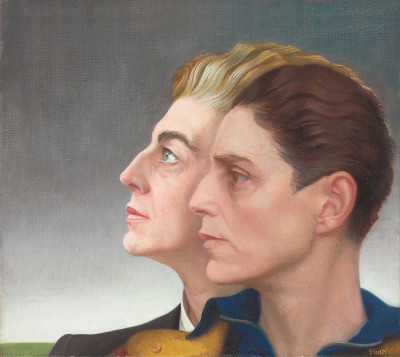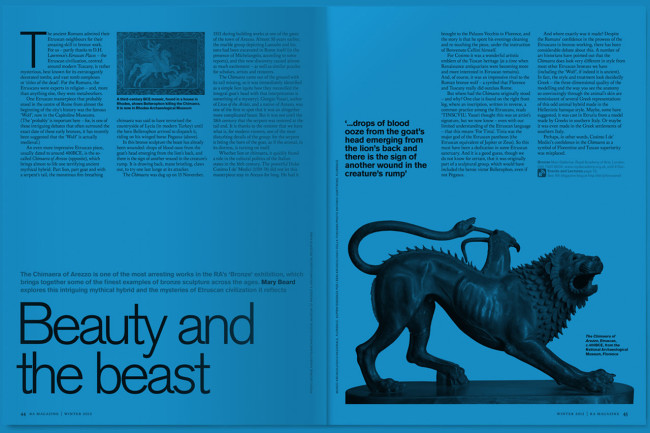“Now it is out”: the 1930s painting that declared lesbian love
“Now it is out”: the 1930s painting that declared lesbian love
By Diana Souhami
Published 6 December 2017
In 1936 British artist Gluck painted herself and her lover in a radical depiction of same-sex partnership. With a show at Brighton Museum and Art Gallery exploring her life and work, we look at the story behind the painting.
-
-
The painter known as Gluck was born Hannah Gluckstein in 1895, into the family who owned the Lyons catering empire. She defied their ideas of a woman’s place. Stylish photographs of her in the 1920s by Hoppé and in the ’3os by Angus McBean show her in men’s clothes with barbered hair. She exhibited her work in a signature tiered frame, only in “one-man shows”, and on the backs of publicity photographs wrote “please return in good condition to Gluck, no prefix, suffix or quotes.”
Gluck referred to Medallion (1936), her double portrait of herself and her lover Nesta Obermer, as the “YouWe” picture and their marriage picture. On 23 June 1936 they’d been to Fritz Busch’s production of Mozart’s Don Giovanni at Glyndebourne. They sat in the third row of the stalls and Gluck felt the intensity of the music fused them into one. The “YouWe” painting followed. It was her public declaration of love and commitment. “Now it is out,” she wrote to Nesta, “and to the rest of the Universe I call Beware! Beware! We are not to be trifled with.”
Medallion has the feel of propaganda art. Gluck appears in the foreground. She was 41 in 1936 and, until this coup de foudre, had been in a four-year relationship with Constance Spry, florist par excellence to royalty and high society. Nesta was 43 with a glittering social life and a wealthy elderly husband whom she had no wish to offend. In Medallion they stare determinedly into their merged future. Nesta’s eye seems lit by paradisal light.
The painting was included in Gluck’s highly praised 1937 exhibition at The Fine Art Society. It hung alongside her portraits of society figures and her exquisite paintings of Spry’s flower arrangements. The Queen visited the gallery on 25 November and according to the Court and Society column of the Daily Mail, “Her Majesty, who was wearing a swagger suit of peacock blue velvet with a hat of the same colour, spent a considerable time discussing the pictures with the artist".
Quite what the Queen made of “YouWe” is not on record. Nine years earlier Radclyffe Hall’s novel The Well of Loneliness had been censored as obscene and destroyed, solely because of its lesbian theme. “I would rather give a healthy boy or a healthy girl a phial of prussic acid than this book,” wrote the Editor of the Sunday Express by way of review.

-
-
-
Gluck’s work – much of which is on show alongside clothing and personal ephemera in Gluck: Art and Identity at Brighton Museum and Art Gallery – was autobiographical and contingent on the woman in her life. With Nesta she painted fleeting scenes of shared times: punting on a lake, Christmas festivities. When the relationship ended because Nesta would not leave her husband, Gluck broke down. Her 1942 self-portrait, used as the poster image for the recent Queer British Art 1861-1967 exhibition at Tate Britain, marked the end of the “YouWe” romantic ideal. It shows her distressed and bereaved.
The significance of Medallion was not openly discussed when Gluck painted it in 1936. Male homosexuality was a criminal offence. There was no acceptable vocabulary for being lesbian or transgendered. Gluck was acclaimed as a society painter of landscapes, portraits and flowers, not as a gender-questioning subversive.
Eighty years on her “YouWe” picture has become an iconic image of same-sex desire. The questions it codes of identity, sexual orientation, same-sex union and equal marriage rights are very much to the fore.
Gluck: Art and Identity is at Brighton Museum and Art Gallery until 11 March 2018.
Diana Souhami is the author of Gluck: Her Biography.

-
-

Gluck, Ephebe - a Tunisian Boy, 1937.

Gluck, The Devil's Altar, 1932.

Gluck, Requiem, 1964.

Gluck, Medallion (YouWe), 1936.
-
A note on language
We know Gluck adopted a gender neutral name and rejected all prefixes, meaning gendered titles which describe a person’s marital status, such as “Miss” and “Mrs”, but also that Gluck was referred to by friends using she/her pronouns and did not dispute this. What we can’t know is how Gluck would want to be referred to today, now there is a more expansive and inclusive range of terminology and pronouns available.Therefore, we allow authors to reach their own informed and respectful conclusions when describing Gluck.
We feel this approach provides space for a dialogue about how we should approach the task of describing this convention-defying artist in the 21st century.
-
-
Enjoyed this article?
Become a Friend to receive RA Magazine
As well as free entry to all of our exhibitions, Friends of the RA enjoy one of Britain’s most respected art magazines, delivered directly to your door.
Why not join the club?

-










